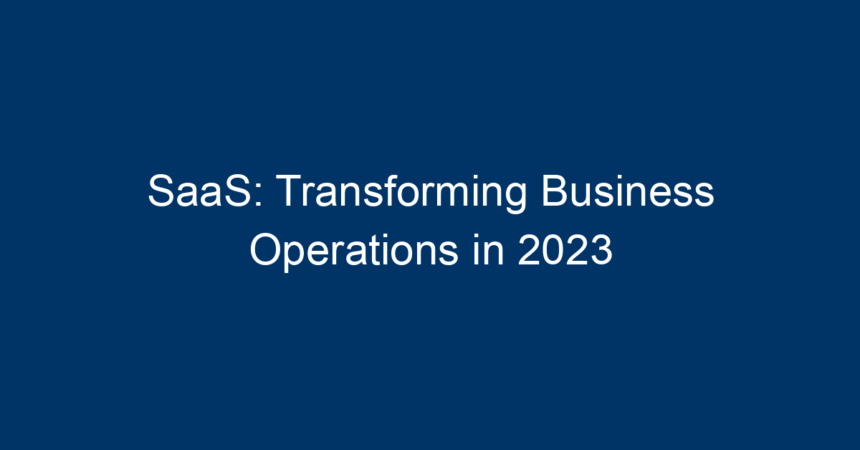In the fast-evolving landscape of 2023, Software as a Service (SaaS) is not just a buzzword; it’s a fundamental pillar in the transformation of business operations. As organizations strive to enhance efficiency, reduce costs, and improve customer experiences, SaaS solutions are rapidly becoming the go-to choice for many. This article delves into how SaaS is reshaping business operations, explores its benefits, and offers actionable insights on how businesses can leverage SaaS solutions effectively.
What is SaaS?
Software as a Service, or SaaS, refers to a cloud computing model where software applications are delivered over the internet. Users access these applications via a web browser, eliminating the need for physical installations and complex maintenance. This model is appealing because it offers scalable solutions adaptable to growing business needs, making it particularly advantageous for startups and established enterprises alike.
The Rise of SaaS in 2023
Cloud Adoption Trends
The past few years have witnessed an unprecedented rise in cloud adoption. According to recent statistics, nearly 85% of businesses have migrated some or all of their operations to the cloud. This shift is propelled by the demand for flexibility, remote work capabilities, and the need for cost-effective solutions.
Remote Workforce Enablement
The COVID-19 pandemic accelerated the trend of remote work, which shows no signs of reversing. SaaS applications facilitate seamless collaboration among remote teams. This paradigm shift has transformed the way businesses operate, leading to the widespread implementation of tools like Zoom, Slack, and Trello.
Key Benefits of SaaS
1. Cost-Effectiveness
SaaS solutions typically operate on a subscription model, allowing businesses to avoid hefty upfront costs associated with traditional software purchases. Organizations can manage their cash flow better and only pay for what they need when they need it. This flexibility is especially beneficial for small to medium-sized enterprises (SMEs).
2. Scalability
Businesses can easily scale their SaaS applications up or down based on their evolving needs. This is particularly valuable during periods of growth or contraction, allowing companies to remain agile and responsive to market conditions.
3. Automatic Updates and Maintenance
With SaaS, the service provider manages software updates, security, and maintenance. This ensures that businesses are always using the latest version without the need to allocate internal resources for updates. As a result, businesses can focus on their core operations instead of worrying about software management.
4. Enhanced Collaboration
Many SaaS applications are specifically designed to enhance collaboration. Real-time editing features, file sharing, and communication tools streamline teamwork, particularly for decentralized teams. This encourages productivity and innovation, as team members can work together regardless of their physical locations.
5. Data Security
Security is a top concern for businesses, especially when handling sensitive customer information. Most reputable SaaS providers invest in advanced security measures, offering encryption, access controls, and regular security audits. This significantly reduces the burden on businesses to maintain their own security infrastructure.
Popular SaaS Solutions Transforming Businesses
1. Customer Relationship Management (CRM)
SaaS-based CRM platforms like Salesforce and HubSpot help businesses manage customer interactions, track leads, and optimize customer relationships. By providing insights through data analytics, these platforms allow businesses to improve customer engagement and retention strategies.
2. Human Resource Management (HRM)
HRM solutions such as BambooHR and Gusto have revolutionized how businesses manage employee records, payroll, and recruitment processes. These platforms streamline HR functions and enhance employee experiences.
3. Project Management Tools
Tools like Monday.com and Asana are at the forefront of project management. They provide functionalities that facilitate task assignments, timelines, and project tracking. This allows teams to stay organized and meet deadlines effectively.
4. Financial Management
SaaS solutions like QuickBooks Online and Xero offer robust financial management capabilities, including accounting, invoicing, and expense tracking. These tools simplify financial tasks, enabling businesses to make informed financial decisions.
5. E-commerce Platforms
For businesses looking to expand online, SaaS e-commerce platforms like Shopify and BigCommerce provide a comprehensive set of tools to build and manage online stores efficiently. These platforms help businesses reach wider audiences and optimize sales processes.
Overcoming Challenges with SaaS
While the benefits of SaaS are numerous, businesses must also navigate several challenges. Here are a few to consider:
1. Vendor Lock-In
Choosing a SaaS provider is a significant decision. Businesses can face vendor lock-in, making switching providers a complex and costly process. Conducting thorough research and selecting a flexible, feature-rich solution is crucial.
2. Data Privacy Concerns
Privacy concerns are paramount. Organizations need to ensure that their chosen SaaS solutions comply with industry standards, such as GDPR. Being proactive about understanding vendor policies regarding data usage and storage is essential.
3. Connectivity Requirements
Since SaaS applications rely on internet connectivity, any downtime can hinder business operations. Implementing backup solutions and ensuring reliable internet service can mitigate this risk.
How to Choose the Right SaaS Solution
1. Identify Business Needs
Before selecting a SaaS solution, it’s essential to assess your organization’s specific needs. Engaging with stakeholders can provide insights into what features will be most beneficial.
2. Evaluate Providers
Research multiple providers, focusing on customer reviews, service level agreements (SLAs), and security measures. A vendor with a solid reputation for customer support can provide peace of mind.
3. Test Before Commitment
Many SaaS providers offer free trials. Take advantage of these trials to understand how the software aligns with your business processes before making a long-term commitment.
4. Assess Integration Capabilities
A SaaS solution should easily integrate with existing tools and systems within your organization. This ensures a smooth transition and enhances overall productivity.
5. Monitor Performance and ROI
After implementation, continually monitor the performance of the SaaS solution against your predefined goals. Assessing return on investment (ROI) helps determine its effectiveness and informs decisions for future software investments.
Conclusion: Embrace the Future with SaaS
SaaS is not merely a trend; it’s a powerful catalyst for change in modern business operations. By leveraging cloud-based solutions, companies can enhance efficiency, reduce costs, and foster collaboration in ways that are simply not feasible with traditional software models.
As we move further into 2023, embracing SaaS will be critical for organizations aiming to stay competitive. By understanding its capabilities and challenges and following best practices, businesses can create an agile, efficient, and innovative operational framework.
Are you ready to transform your business operations with SaaS? Start exploring the myriad of solutions available today and see how they can drive your organization forward!




